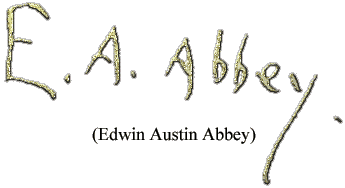


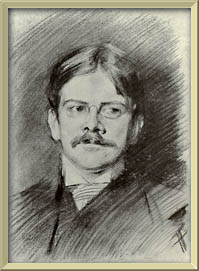
|
Portrait of Abbey (ca 1889) |
Six Abbey pictures |
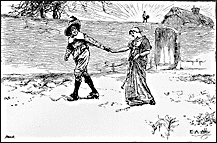 Born in 1852, Edwin Austin Abbey was on staff
at Harpers by the time he was 19 and, despite success,
recognition and raises, he left to pursue a free-lance career
at the age of 22. He returned to Harpers in 1876, at the
ripe old age of 24, a wily veteran at the princely sum of $50
a week (more than three times his 1871 initial salary). 1876 was
also the American Centennial and one of the many celebratory events
was the Centennial Exhibition which brought a wide selection
of European paintings to Philadelphia. Abbey was inspired by the
English contingent: Leighton, Watt, Boughton, and others. Already
a proponent of drawing from life, the work of the Pre-Raphaelites
inspired him further. This led to a journey to England in 1878
in the cause of accuracy in his drawings for Herrick's Poems.
He remained there for most of his life.
Born in 1852, Edwin Austin Abbey was on staff
at Harpers by the time he was 19 and, despite success,
recognition and raises, he left to pursue a free-lance career
at the age of 22. He returned to Harpers in 1876, at the
ripe old age of 24, a wily veteran at the princely sum of $50
a week (more than three times his 1871 initial salary). 1876 was
also the American Centennial and one of the many celebratory events
was the Centennial Exhibition which brought a wide selection
of European paintings to Philadelphia. Abbey was inspired by the
English contingent: Leighton, Watt, Boughton, and others. Already
a proponent of drawing from life, the work of the Pre-Raphaelites
inspired him further. This led to a journey to England in 1878
in the cause of accuracy in his drawings for Herrick's Poems.
He remained there for most of his life.
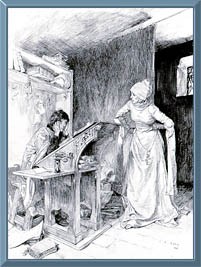 His pen work, though always excellent, took
on a new dimension. The sketching "rambles" he experienced
in England with Alfred Parsons and George Boughton reinforced
his belief in the value of drawing from the source. His ink drawings
were still being engraved on wood, so some of the spontaneity
is lost. Like Daniel
Vierge, Abbey was quick to see the advantage of "process"
reproduction of his pen drawings ("process" being any
of several photographic processes that eliminated the engraver's
reinterpretation). While in England he produced illustrations
for many Harpers serials including "She Stoops to
Conquer" (collected as a sumptuous book in 1887), "Old
Songs" (right), and "Judith Shakespeare"
(the first two were also published in book form with Abbey's illustrations).
While in Europe, he met and was inspired by the great French and
English artists of the day. His friendship with Sargent is evidenced
by the portrait at the top of this page. Abbey often lived at
his studio in Broadway and they painted together often. He was
also friends with Alma-Tadema, DuMaurier, Whistler, and others.
And though he was painting throughout, he still was using the
pen as his primary artistic tool. This prowess with the pen led
Harpers to assign him a series of illustrations for Shakespeare's
comedies in 1887.
His pen work, though always excellent, took
on a new dimension. The sketching "rambles" he experienced
in England with Alfred Parsons and George Boughton reinforced
his belief in the value of drawing from the source. His ink drawings
were still being engraved on wood, so some of the spontaneity
is lost. Like Daniel
Vierge, Abbey was quick to see the advantage of "process"
reproduction of his pen drawings ("process" being any
of several photographic processes that eliminated the engraver's
reinterpretation). While in England he produced illustrations
for many Harpers serials including "She Stoops to
Conquer" (collected as a sumptuous book in 1887), "Old
Songs" (right), and "Judith Shakespeare"
(the first two were also published in book form with Abbey's illustrations).
While in Europe, he met and was inspired by the great French and
English artists of the day. His friendship with Sargent is evidenced
by the portrait at the top of this page. Abbey often lived at
his studio in Broadway and they painted together often. He was
also friends with Alma-Tadema, DuMaurier, Whistler, and others.
And though he was painting throughout, he still was using the
pen as his primary artistic tool. This prowess with the pen led
Harpers to assign him a series of illustrations for Shakespeare's
comedies in 1887.
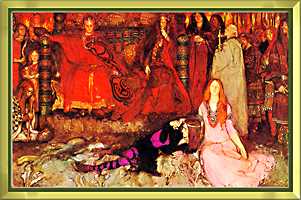 After a short trip back to New York in 1889,
he immediately returned to England, where the lure of authentic
costumes could not be denied. On the trip, he convinced himself
that his future should be in oil painting. The Shakespeare illustrations,
which would continue until 1909, were executed in many media:
pen, oil, watercolor and pencil. These were some of his first
published oil paintings and his European experience continued
to pay dividends. At left is The Play Scene in Hamlet
from 1897. Though not part of the Harpers series (this
being a submission to the Royal Academy of that year), the composition,
staging and power of his work from this period is stunning. And
the access to the costumes and stage props so readily available
in England lends a sense of reality often missing elsewhere. He
also traveled to Italy for more research.
After a short trip back to New York in 1889,
he immediately returned to England, where the lure of authentic
costumes could not be denied. On the trip, he convinced himself
that his future should be in oil painting. The Shakespeare illustrations,
which would continue until 1909, were executed in many media:
pen, oil, watercolor and pencil. These were some of his first
published oil paintings and his European experience continued
to pay dividends. At left is The Play Scene in Hamlet
from 1897. Though not part of the Harpers series (this
being a submission to the Royal Academy of that year), the composition,
staging and power of his work from this period is stunning. And
the access to the costumes and stage props so readily available
in England lends a sense of reality often missing elsewhere. He
also traveled to Italy for more research.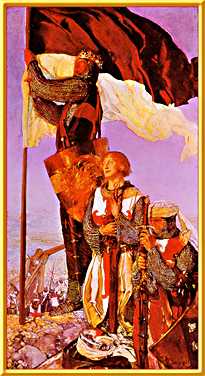 In 1890 he received the commission for the
Holy Grail murals at the Boston Public Library. The first half
were completed and installed in 1895, the remainder in 1901. That
year Abbey was elected President of the Royal Birmingham Society
of Artists. He lived in London until his death in 1911.
In 1890 he received the commission for the
Holy Grail murals at the Boston Public Library. The first half
were completed and installed in 1895, the remainder in 1901. That
year Abbey was elected President of the Royal Birmingham Society
of Artists. He lived in London until his death in 1911.
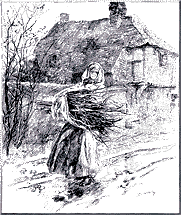 Another easel painting was The Crusaders
Sighting Jerusalem from 1901, at left. Again, his insistence
on accuracy provides a most dynamic image. Always a popular artist,
in 1902, he illustrated an edition of Oliver Goldsmith's The
Deserted Village (Goldsmith also wrote She
Stoops to Conquer, one of his earliest successes). The illustration
at right demonstrates the continued development with the pen,
especially is the sense of spontaneity of line.
Another easel painting was The Crusaders
Sighting Jerusalem from 1901, at left. Again, his insistence
on accuracy provides a most dynamic image. Always a popular artist,
in 1902, he illustrated an edition of Oliver Goldsmith's The
Deserted Village (Goldsmith also wrote She
Stoops to Conquer, one of his earliest successes). The illustration
at right demonstrates the continued development with the pen,
especially is the sense of spontaneity of line.
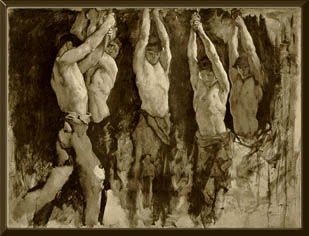 That year, Abbey also accepted his second
great mural commission: the new state capitol at Harrisburg, Pennsylvania.
The images for these murals show him working from the nude model
and the resultant figure studies, like Men at an Anvil
at right, leave absolutely no doubt as to his prowess and talent.
It's just an oil sketch, circa 1904-08, but the intensity and
strength is amazing. Abbey died before completing the murals.
They were finished by J.S. Sargent. A most excellent biography
by E.V. Lucas, with two hundred b&w, mostly photogravure,
illustrations, was published in 1921 titled: Life and Work
of Edwin Austin Abbey, R.A. It is highly recommended. A limited
edition with an original Abbey drawing exists.
That year, Abbey also accepted his second
great mural commission: the new state capitol at Harrisburg, Pennsylvania.
The images for these murals show him working from the nude model
and the resultant figure studies, like Men at an Anvil
at right, leave absolutely no doubt as to his prowess and talent.
It's just an oil sketch, circa 1904-08, but the intensity and
strength is amazing. Abbey died before completing the murals.
They were finished by J.S. Sargent. A most excellent biography
by E.V. Lucas, with two hundred b&w, mostly photogravure,
illustrations, was published in 1921 titled: Life and Work
of Edwin Austin Abbey, R.A. It is highly recommended. A limited
edition with an original Abbey drawing exists.
 The research Abbey did for the
Harpers Shakespeare Comedies and Tragedies series
was put to excellent use in his many award-winning easel paintings.
The wrap-around fold-out cover of the 1974 Yale University
Exhibition Catalog (at left) is from Richard III, Richard,
Duke of Gloucester, and the Lady Anne, from 1896. (Richard,
in red, is proposing to the widow of the man he has just murdered
in the midst of the funeral procession.) This catalog is an excellent
source of information on and images by Abbey. It provides some
of the few color reproductions I've seen (though The Illustrator
in America has two - including Richard...). The many
illustrations done for the turn-of-the-century magazines were
all reproduced in b&w and were most likely executed in tones
rather than color.
The research Abbey did for the
Harpers Shakespeare Comedies and Tragedies series
was put to excellent use in his many award-winning easel paintings.
The wrap-around fold-out cover of the 1974 Yale University
Exhibition Catalog (at left) is from Richard III, Richard,
Duke of Gloucester, and the Lady Anne, from 1896. (Richard,
in red, is proposing to the widow of the man he has just murdered
in the midst of the funeral procession.) This catalog is an excellent
source of information on and images by Abbey. It provides some
of the few color reproductions I've seen (though The Illustrator
in America has two - including Richard...). The many
illustrations done for the turn-of-the-century magazines were
all reproduced in b&w and were most likely executed in tones
rather than color.
Abbey can lay claim to being America's first great illustrator. His work was inspirational and influential during his life and remains so today.
Here's a wonderful image I just discovered in the 1924
Penrose's Annual. It's titled,
"O,
Mistress Mine where are you roaming?"


| Modern Pen Drawing: European and American (1901) | Charles Holme, 1901 The Studio |
| Pen Drawing and Pen Draughtsmen | Joseph Pennell, 1920 Macmillan |
| Life and Work of Edwin Austin Abbey, R.A. | E.V. Lucas, 1921 Scribners (NY) and Methuen (London) |
| Edwin Austin Abbey (1852-1911) | Alan Shestack, 1973 Yale University |
| The Illustrator in America 1880 to 1980 | Walt and Roger Reed, 1984 Madison Square Press |
| The Vadeboncoeur Collection of Knowledge | Jim Vadeboncoeur, Jr. 1998 |
| The Vadeboncoeur Collection of ImageS 3, B&W ImageS 5 | Jim Vadeboncoeur, Jr. 2002, 2010 JVJ Publishing |
|
Illustrations copyright by their respective owners. This page written, designed & © 1998 by Jim Vadeboncoeur, Jr. Updated 2011. |
Learn about other ILLUSTRATORS
